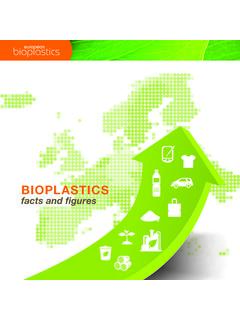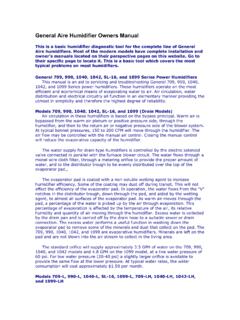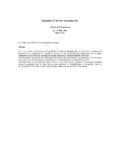Transcription of PERFORMANCE IN INDUSTRIAL COMPOSTING
1 BACK. European Bioplastics Marienstr. 19/20 10117 Berlin GROUND European Bioplastics APR 2015. Marienstr. 19/20, 10117 Berlin phone + 48 23 50. fax + 48 23 59. e-mail web EN 13432 CERTIFIED BIOPLASTICS. PERFORMANCE IN INDUSTRIAL COMPOSTING . VR 19997 Nz, Amtsgericht Charlottenburg, USt-IdNr. DE235874231. HypoVereinsbank Rosenheim, BLZ 711 200 77, Konto 6356800, IBAN DE26 7112 0077 0006 3568 00, BIC/SWIFT HYVEDEMM448. BACK. GROUND. APR 2015. European Bioplastics Marienstr. 19/20 10117 Berlin European Bioplastics Marienstr. 19/20, 10117 Berlin 1. INTRODUCTION phone + 48 23 50. fax + 48 23 59. The Directive on Packaging and Packaging Waste (PPWD) was first issued e-mail web in 1994. Its main purpose was to increase the recovery rate of packaging waste and to cut disposal (landfilling).
2 Apart from mechanical recycling ORGANIC WASTE. also biological (organic) recycling1 was defined, and a specific standard for identifying "packaging recoverable by means of biodegradation and - from households and industry COMPOSTING " was requested from CEN. The standard prepared under the EC - seperately collected Mandate M2002 was finalised in 2000 at the same time as other standards on reuse, mechanical recycling and energy recovery. However, it was the only one to be immediately accepted by the EC as a harmonised standard3, while another round of standardisation work was required for the others. The EN 13432 standard Packaging - Requirements for packaging recove- rable through COMPOSTING and biodegradation - Test scheme and evaluation WASTE COLLECTION.
3 Criteria for the final acceptance of packaging specifies requirements and procedures to determine the compostability and anaerobic treatability of packaging and packaging materials. It addresses the following characte- ristics: biodegradability, disintegration during biological treatment, effect on the biological treatment process and effect on the quality of the resulting Anaerobic Home INDUSTRIAL compost. Typical examples of compostable plastics are cellulose films, starch COMPOSTING COMPOSTING digestion blends, polylactic acid and PBAT4. Biodegradability does not depend on the origin of the material but exclusively on its chemical structure. The term bioplastics thereby refers to plastics that are biobased, biodegradable or both5. FIGURE 1: OPTIONS FOR ORGANIC WASTE MANAGEMENT.
4 This paper aims to show that the requirements for bioplastics to be certified according to EN 13432 are well described and more than sufficient to make This paper focuses exclusively on the PERFORMANCE of EN 13432 certified them processable for INDUSTRIAL COMPOSTING . Furthermore, EN 13432 certified plastics in INDUSTRIAL COMPOSTING and does not consider its suitability for home packaging and bags can positively contribute to an increased collection of COMPOSTING or other means of disposal. The paper begins by introducing organic waste, leading to a diversion of organic waste out of landfills and the most important aspects of EN 13432 and provides insight into existing into biological treatment, thereby reducing methane emissions from landfills6.
5 COMPOSTING infrastructures and mechanisms. 2. FACTS ABOUT EN 13432. The requirements for bioplastics to be certified as compostable have been Disintegration, namely fragmentation and loss of visibility in the final well established and proven in different field tests. The European standard compost - this is measured in a pilot COMPOSTING test (EN 14045) in EN 13432 defines the minimum requirements packaging has to meet in which specimens of the test material are composted with biowaste for order to be processed by INDUSTRIAL COMPOSTING . Similar requirements are 3 months. After this time, the mass of test material residues has to in place in the European Standard EN 14995 for non-packaging plastic amount to less than 10% of the original mass.
6 Items. EN 13432 requires that the following four characteristics are tested in a laboratory: 1. European Directive 94/62/EC of 20 December 1994. Article 3, Paragraph 9. Organic recycling' shall mean the aerobic ( COMPOSTING ) or anaerobic (biomethanisation) treatment, under controlled conditions and using microorganisms, of the biodegradable parts of packaging waste, which produces stabilized organic residues or methane. Landfill is not considered to be a form of organic recycling. Official Journal L 365 , 31/12/1994 P. 0010 - 0023. 2. M/200 Mandate to CEN for standardisation and study related to packaging and packaging waste 3. 2001/524/EC: Commission decision of 28 June 2001. Official Journal L 190, 12/07/2001 P. 0021 - 0023. 4. Poly(butylene adipate-co-terephthalate).
7 5. The term bioplastics constitutes two main groups: 1. Biobased, non-biodegradable plastics, such as biobased PE or biobased PET; 2. Compostable / biodegradable plastics, starch blends or PLA. 6 VR 19997. As compostable Nz, products are Amtsgericht usually rich in carbon Charlottenburg, and low in nitrogen they canUSt-IdNr. DE235874231. also have a favourable influence on the C/N ratio of biowaste and the resulting compost. Biowaste often has a low C/N ratio leading to ammonia toxicity HypoVereinsbank and odour Rosenheim, problems. Compostable products thus can makeBLZ 711 200. the separate adding77, Kontoco-substrates of carbon-rich 6356800, IBAN unnecessary. to biowaste DE26 7112 0077 0006 3568 00, BIC/SWIFT HYVEDEMM448. 2. BACK. GROUND. APR 2015.
8 European Bioplastics Marienstr. 19/20 10117 Berlin European Bioplastics Marienstr. 19/20, 10117 Berlin Biodegradability, namely the capability of the compostable material to Amount of heavy metals phonehas to+ be below given 48 23maximum 50 values, and be converted into CO2 under the action of microorganisms. The standard the final compost must fax not be+ affected negatively 48 23 59 (no reduction of contains a mandatory threshold of at least 90 percent biodegradation that agronomic value ande-mail no ecotoxicological effects on plant growth). web must be reached in less than 6 months (laboratory test method EN. 14046). The following section shows that biodegradable plastics meeting the Absence of negative effects on the COMPOSTING process.
9 Requirements of EN 13432 perform well in INDUSTRIAL COMPOSTING plants. 3. COMPOSTING INFRASTRUCTURE. In quite a number of European countries, Austria, Belgium, Germany, Italy and the Netherlands, INDUSTRIAL COMPOSTING is already well established and a widely accepted part of the waste recovery infrastructure. Other EU. countries still need to catch up to achieve an equivalent level of INDUSTRIAL COMPOSTING . However, a decent separate waste collection system is funda- mental to implementing organic recycling and thus INDUSTRIAL Plastics certified according to EN 13432 can be recognised by the Seed- ling logo (figure 2). Together with a proper communication, this label helps consumers to correctly identify the compostable material. The certified, compostable plastics are sent to INDUSTRIAL COMPOSTING plants by disposal as FIGURE 2: THE SEEDLING LOGO (EUROPEAN BIOPLASTICS TRADEMARK) IS A LABEL FOR COMPOSTABLE.
10 Organic waste, whereas non-compostable plastics can be treated as usual PACKAGING CERTIFIED ACCORDING TO EN 13432. in the appropriate waste streams ( mechanical recycling). 4. ( INDUSTRIAL ) COMPOSTING MECHANISM. INDUSTRIAL COMPOSTING is a controlled process that can be divided into two dis- temperatures in the lower mesophilic range (< 40 C) with synthesis of humic tinct phases: active COMPOSTING (rotting) followed by curing (post-rotting). The substances. In practice, a broad range of COMPOSTING plant technologies duration of the active COMPOSTING phase depends on the type of COMPOSTING . exists. Table 1 (adapted from the study from 20118) gives an Under normal COMPOSTING conditions, microorganisms grow on the organic overview of the six most commonly used COMPOSTING systems in Germany9.







